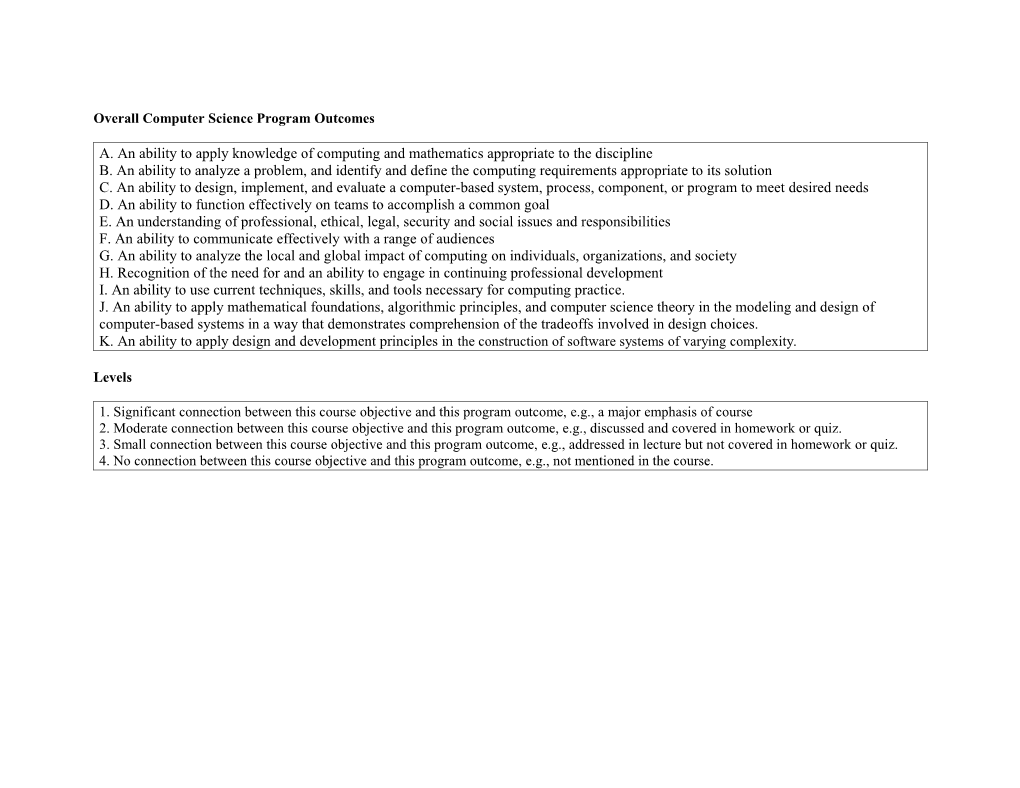Overall Computer Science Program Outcomes
A. An ability to apply knowledge of computing and mathematics appropriate to the discipline
B. An ability to analyze a problem, and identify and define the computing requirements appropriate to its solution
C. An ability to design, implement, and evaluate a computer-based system, process, component, or program to meet desired needs
D. An ability to function effectively on teams to accomplish a common goal
E. An understanding of professional, ethical, legal, security and social issues and responsibilities
F. An ability to communicate effectively with a range of audiences
G. An ability to analyze the local and global impact of computing on individuals, organizations, and society
H. Recognition of the need for and an ability to engage in continuing professional development
I. An ability to use current techniques, skills, and tools necessary for computing practice.
J. An ability to apply mathematical foundations, algorithmic principles, and computer science theory in the modeling and design of computer-based systems in a way that demonstrates comprehension of the tradeoffs involved in design choices.
K. An ability to apply design and development principles in the construction of software systems of varying complexity.
Levels
1. Significant connection between this course objective and this program outcome, e.g., a major emphasis of course
2. Moderate connection between this course objective and this program outcome, e.g., discussed and covered in homework or quiz.
3. Small connection between this course objective and this program outcome, e.g., addressedin lecture but not covered in homework or quiz.
4. No connection between this course objective and this program outcome, e.g., not mentioned in the course.
ABET Requirement Specifications for A-K (Computing) Criteria
Course: CS 4264 Prepared by: C.J. Ribbens Date: 3/1/2012
Course Learning Objective / Overall Program Outcome (Enter level number)1 / identify classes of security problems in computer systems and networks / A / B / C / D / E / F / G / H / I / J / K
What will be measured to demonstrate that this learning objective has been achieved?
Homework and test questions. / 2 / 2 / 1 / 4 / 1 / 4 / 3 / 4 / 3 / 3 / 4
2 / model threats, risks, attacks, and security goals / A / B / C / D / E / F / G / H / I / J / K
What will be measured to demonstrate that this learning objective has been achieved?
Homework and test questions. / 1 / 2 / 2 / 4 / 1 / 4 / 4 / 4 / 3 / 2 / 4
3 / identify causes of system and network vulnerabilities / A / B / C / D / E / F / G / H / I / J / K
4 / What will be measured to demonstrate that this learning objective has been achieved?
Homework and test questions. / 2 / 2 / 2 / 4 / 2 / 3 / 4 / 4 / 3 / 3 / 4
4 / describe classic and modern security approaches and techniques / A / B / C / D / E / F / G / H / I / J / K
What will be measured to demonstrate that this learning objective has been achieved?
Homework and test questions. / 2 / 2 / 2 / 4 / 2 / 3 / 4 / 4 / 3 / 3 / 4
5 / compare pros and cons of various security solutions in terms of their security guarantees / A / B / C / D / E / F / G / H / I / J / K
What will be measured to demonstrate that this learning objective has been achieved?
Homework and test questions. / 2 / 1 / 1 / 4 / 2 / 3 / 4 / 4 / 3 / 2 / 4
6 / design and implement techniques for achieving secure operating systems, communication, and computation; / A / B / C / D / E / F / G / H / I / J / K
What will be measured to demonstrate that this learning objective has been achieved?
Course projects / 1 / 1 / 1 / 3 / 2 / 4 / 4 / 4 / 2 / 3 / 2
7 / evaluate the security, robustness, usability and efficiency of security tools / A / B / C / D / E / F / G / H / I / J / K
What will be measured to demonstrate that this learning objective has been achieved?
Homework projects. / 1 / 2 / 1 / 4 / 2 / 3 / 4 / 4 / 3 / 2 / 4
Updated 10/1/2008
